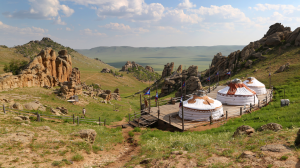Mongolia Research
The fortified Toyota Land Cruiser slipped and bounced in the muddy hollows of the rain-drenched Mongolian steppe. The driver, a native Mongolian man named Inka who spoke little English, slowly engineered the vehicle along what just two days earlier was a dusty pair of dirt tracks.
In the back seat of the Cruiser, Duke master of science in global health students Laura Pulscher and Thomas Moore braced themselves during the ride as best they could, relaxing when Inka stopped the vehicle to ask a goat herder for directions.
Pulscher, unfazed by hours of jouncing, said slowly with a matter-of-fact smile, “We’re lost.”
It’s a commonly uttered phrase for visitors and natives alike. A meager 10 percent of Mongolia’s road network is paved. The vast majority of travel in this vast, storied land of Genghis Khan is done on dirt trails and grassy paths.
“If you had asked me before beginning the global health master’s program that I’d be coming to Mongolia, I would have laughed,” Moore would say later at a campsite on the edge of a livestock pasture.
But Mongolia was the opportunity presented to Moore and Pulscher to conduct their field research projects, and they both barely blinked before saying yes.
“It’s one thing to learn something in a classroom setting,” Pulscher said, “but another to actually apply it to your field of study in a developing nation. I don’t think it ever crossed my mind that I’d end up in Mongolia.”
Yet, there they were for three months.
Early in their three month stay in Mongolia, Moore and Pulscher spent three weeks traveling north from the capital of Ulaanbaatar toward the Siberian border. With them in a second vehicle were veterinarians Myagmarsuk “Myagaa” Yondon; Igori “Khatnaa” Khatanbaatar; and Purevdorj “Zula” Munkhzul from the Mongolian Institute of Veterinary Medicine, who collected blood samples from herders’ horses, goats, and sheep. Moore and Pulscher captured small rodents—Mongolian gerbils, Daurian ground squirrels, Siberian chipmunks, hamsters and field mice—in humane, live animal traps, and injected them with a mild sedative.
Pulscher collected blood and serum samples from the animals’ tails and took small ear biopsies. Moore’s work was far more tedious—combing the oft-matted fur of the rodents, in search of ticks.
Their individual projects differed, but the students’ goals were the same: to detect in rodents’ blood and ticks the presence of dangerous pathogens—Borrelia (Lyme disease), Rickettsia (spotted fever), and anaplasma (blood disease seen mostly in livestock but can cause mild fever in humans) – and share lab results with local health officials and veterinarians who could take prophylactic measures, such as educating herders and their families about ways to protect themselves and their livestock.
In Mongolia, animals have near royalty status. It is a nation of just 3 million people and more than 50 million horses, camels, sheep, goats, and yaks, which are serious players in the economic cycle, and critical for the more than one million herder families who feed off their livestock and make a living selling animals for meat, hides, or wool.
“Observing these diseases as they circulate throughout wildlife and livestock has a tremendous impact on the health and welfare of humans here,” Moore said.



